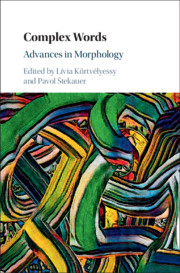Book contents
- Complex Words
- Complex Words
- Copyright page
- Dedication
- Contents
- Contributors
- Introduction: Advances in Morphology
- Part I Lexico-Semantic Aspects of Complex Words
- 1 Formal Semantics and the Problem of Nominalizations
- 2 Semantically Subtractive Morphology
- 3 -less and -free
- 4 Instrument Nouns in -one in Latin and Romance
- 5 Prominence in Noun-to-Verb Conversion
- 6 On Spanish Dvandva and Its Restrictions
- Part II Structure of Complex Words
- Part III Corpus-Based Case Studies
- Index
- References
6 - On Spanish Dvandva and Its Restrictions
from Part I - Lexico-Semantic Aspects of Complex Words
Published online by Cambridge University Press: 18 September 2020
- Complex Words
- Complex Words
- Copyright page
- Dedication
- Contents
- Contributors
- Introduction: Advances in Morphology
- Part I Lexico-Semantic Aspects of Complex Words
- 1 Formal Semantics and the Problem of Nominalizations
- 2 Semantically Subtractive Morphology
- 3 -less and -free
- 4 Instrument Nouns in -one in Latin and Romance
- 5 Prominence in Noun-to-Verb Conversion
- 6 On Spanish Dvandva and Its Restrictions
- Part II Structure of Complex Words
- Part III Corpus-Based Case Studies
- Index
- References
Summary
As noted by Bauer, real dvandva compounds – that is, coordinative compounds that properly express the aggregation of two different entities, not the intersection of properties in one entity – are extremely rare in English and Spanish. This article explores the empirical domain of dvandva compounding in Spanish, and notes that they are productive when not used as heads within their phrases. We propose that the explanation for this is that Spanish can only productively build dvandva compounds using flat structures without internal hierarchy. This causes the compound to look externally for a head noun that defines the interpretation of the relation established between the two members of the dvandva. The proposal also explains why proper names are preferred in dvandva compounding, given that they do not denote properties.
- Type
- Chapter
- Information
- Complex WordsAdvances in Morphology, pp. 100 - 116Publisher: Cambridge University PressPrint publication year: 2020



